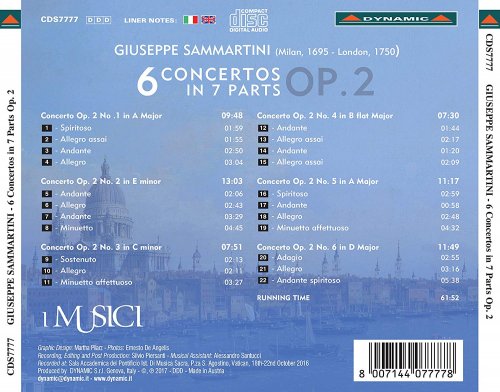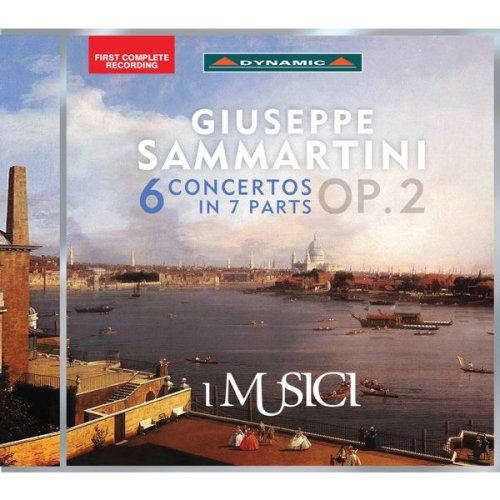
I Musici - Sammartini: 6 Concertos in 7 Parts, Op. 2 (2017)
BAND/ARTIST: I Musici
- Title: Sammartini: 6 Concertos in 7 Parts, Op. 2
- Year Of Release: 2017
- Label: Dynamic
- Genre: Classical, Baroque Era
- Quality: flac lossless
- Total Time: 01:01:26
- Total Size: 334 mb
- WebSite: Album Preview

Tracklist
---------
01. Concerto Grosso in A Major, Op. 2 No. 1: I. Spiritoso
02. Concerto Grosso in A Major, Op. 2 No. 1: II. Allegro assai
03. Concerto Grosso in A Major, Op. 2 No. 1: III. Andante
04. Concerto Grosso in A Major, Op. 2 No. 1: IV. Allegro
05. Concerto Grosso in E Minor, Op. 2 No. 2: I. Andante
06. Concerto Grosso in E Minor, Op. 2 No. 2: II. Allegro
07. Concerto Grosso in E Minor, Op. 2 No. 2: III. Andante
08. Concerto Grosso in E Minor, Op. 2 No. 2: IV. Minuetto
09. Concerto Grosso in C Minor, Op. 2 No. 3: I. Sostenuto
10. Concerto Grosso in C Minor, Op. 2 No. 3: II. Allegro
11. Concerto Grosso in C Minor, Op. 2 No. 3: III. Minuet affetuoso
12. Concerto Grosso in B-Flat Major, Op. 2 No. 4: I. Andante
13. Concerto Grosso in B-Flat Major, Op. 2 No. 4: II. Allegro assai
14. Concerto Grosso in B-Flat Major, Op. 2 No. 4: III. Andante
15. Concerto Grosso in B-Flat Major, Op. 2 No. 4: IV. Allegro assai
16. Concerto Grosso in A Major, Op. 2 No. 5: I. Spiritoso
17. Concerto Grosso in A Major, Op. 2 No. 5: II. Andante
18. Concerto Grosso in A Major, Op. 2 No. 5: III. Allegro
19. Concerto Grosso in A Major, Op. 2 No. 5: IV. Minuetto affetuoso
20. Concerto Grosso in D Major, Op. 2 No. 6: I. Adagio
21. Concerto Grosso in D Major, Op. 2 No. 6: II. Allegro
22. Concerto Grosso in D Major, Op. 2 No. 6: III. Andante spiritoso
After hearing I Musici perform, Arturo Toscanini remarked, "Twelve individual instrumental masters, and together the finest chamber orchestra in the world." This Italian ensemble has long attracted international attention for their emphasis on brilliance, strength of attack, and high level of discipline, beginning with their first performances of seventeenth and eighteenth century Italian music. The group was formed in March 1952 by 12 students at the Accademia di Santa Cecilia, Rome, who developed a common interest in pre-Classical music during conservatory meetings. Upon origination the ensemble was composed of six violins, two violas, two cellos, a double bass, and a harpsichord; there were three women and nine men. Nearly all of the original violinists were pupils of the same Accademia teacher, Remy Principe. The name "I Musici," literally "The Musicians," was chosen by the performers to reflect their enthusiasm for the spirit of the music of an epoch in which "professionalism" had not yet assumed its present pervasive significance. They came together with the single purpose of expressing their deep love for music, and the purity of their intention is heard at performances and on recordings. Making their debut performance at the Accademia in 1952, I Musici began to achieve international fame the following year. Their career developed rapidly, beginning with concert tours throughout Europe. They then toured Central, North and South America, South Africa, Japan, and Australia. They have also played at many music festivals, including those of Salzburg, Holland, Graz, Menton, Venice, York, Copenhagen, Aix-en-Provence, and Edinburgh. Early in their career, they primarily played the music of Italian Baroque composers such as Albinoni, Bononcini, Corelli, Locatelli, Alessandro Scarlatti, Torelli, and Vivaldi, later taking on the non-Baroque works of Bach, Barber, Bartók, Britten, Handel, Hindemith, Martin, and Respighi. One of the most characteristic (and widely influential) features of the ensemble is its lack of a conductor during performance. Felix Ayo, leader of the group between 1952-1968, has said that "to perform without a conductor is normal, I think. It is in the true tradition of the élite music of the Italian Baroque. One finds a conductor only later, after Vivaldi and Corelli. Before, with the concerto grosso and the concerto da camera, there was only the first violin giving the start and tempo with some head movements. And that was all." Among I Musici, Ayo said, music making is a democratic experience. "During rehearsals, the music is discussed by everyone. Everyone's opinion has the same value. It is by mutual agreement that we finally decide how certain details should be handled." The group does have a leader, however; the post has changed hands over the years between Ayo, Roberto Michelucci (1968-1972); conductor, music director, and virtuoso violinist Salvatore Accardo (1972-1977); Boccherini Quintet and Carmirelli Quartet founder Pina Carmirelli (1977-1986); and Federico Agostini. I Musici over the years has constantly built upon its strengths, and the group members to apply the same dedication to their artistry as they did upon formation. Their performances can be heard on over 45 recordings, almost all under the Philips label, at times with flute and harp.
Year 2017 | Classical | FLAC / APE
As a ISRA.CLOUD's PREMIUM member you will have the following benefits:
- Unlimited high speed downloads
- Download directly without waiting time
- Unlimited parallel downloads
- Support for download accelerators
- No advertising
- Resume broken downloads


